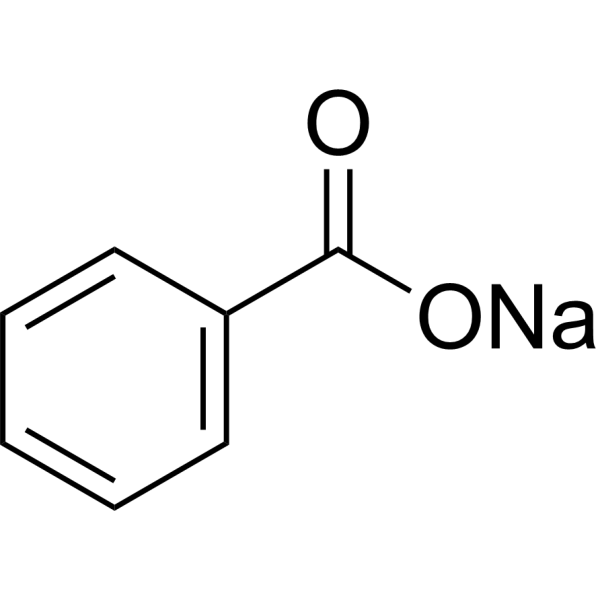Sodium Benzoate

Sodium Benzoate structure
|
Common Name | Sodium Benzoate | ||
|---|---|---|---|---|
| CAS Number | 532-32-1 | Molecular Weight | 144.10 | |
| Density | 1,44 g/cm3 | Boiling Point | 249.3ºC at 760 mmHg | |
| Molecular Formula | C7H5NaO2 | Melting Point | >300 °C(lit.) | |
| MSDS | Chinese USA | Flash Point | 111.4ºC | |
| Symbol |

GHS07 |
Signal Word | Warning | |
|
Antibacterial activity of fluoride compounds and herbal toothpastes on Streptococcus mutans: an in vitro study.
Aust. Dent. J. 60 , 368-74, (2015) Streptococcus mutans is an important bacterial species implicated in dental caries. This laboratory study compared the antimicrobial activity of a number of fluoride containing and herbal dentifrices and their components against S. mutans.An agar diffusion me... |
|
|
Role of type I & type II radicals in DNA damage and activation of Caspase 3 via mitochondrial pathway induced by photosensitized benzophenone
Toxicol. Lett. 235(2) , 84-95, (2015) [Display omitted] |
|
|
Novel UV-spectrophotometric method for quantitative estimation of furazolidone using mixed hydrotropic agent.
Pak. J. Pharm. Sci. 26(1) , 159-62, (2013) A novel, eco friendly, accurate, sensitive, economic and safe spectrophotometric method was developed by application of mixed hydrotropy using 2 M sodium acetate, 8 M urea, 2 M niacinamide and 2 M sodium benzoate solution (25:25:25:25% V/V) as hydrotropic age... |
|
|
Carbonic anhydrase inhibitors. Interaction of isozymes I, II, IV, V, and IX with carboxylates.
Bioorg. Med. Chem. Lett. 15 , 573-8, (2005) A detailed inhibition study of five carbonic anhydrase (CA, EC 4.2.1.1) isozymes with carboxylates including aliphatic (formate, acetate), dicarboxylic (oxalate, malonate), hydroxy/keto acids (l-lactate, l-malate, pyruvate), tricarboxylic (citrate), or aromat... |
|
|
Cheminformatics analysis of assertions mined from literature that describe drug-induced liver injury in different species.
Chem. Res. Toxicol. 23 , 171-83, (2010) Drug-induced liver injury is one of the main causes of drug attrition. The ability to predict the liver effects of drug candidates from their chemical structures is critical to help guide experimental drug discovery projects toward safer medicines. In this st... |
|
|
Carbonic anhydrase inhibitors. Inhibition of the beta-class enzymes from the fungal pathogens Candida albicans and Cryptococcus neoformans with aliphatic and aromatic carboxylates.
Bioorg. Med. Chem. 17 , 2654-7, (2009) The inhibition of the beta-carbonic anhydrases (CAs, EC 4.2.1.1) from the pathogenic fungi Cryptococcus neoformans (Can2) and Candida albicans (Nce103) with carboxylates such as the C1-C5 aliphatic carboxylates, oxalate, malonate, maleate, malate, pyruvate, l... |
|
|
Carbonic anhydrase inhibitors. Inhibition of the β-class enzymes from the fungal pathogens Candida albicans and Cryptococcus neoformans with branched aliphatic/aromatic carboxylates and their derivatives.
Bioorg. Med. Chem. Lett. 21 , 2521-6, (2011) The inhibition of the β-carbonic anhydrases (CAs, EC 4.2.1.1) from the pathogenic fungi Cryptococcus neoformans (Can2) and Candida albicans (Nce103) with a series of 25 branched aliphatic and aromatic carboxylates has been investigated. Human isoforms hCA I a... |
|
|
Effect of preservatives on Shiga toxigenic phages and Shiga toxin of Escherichia coli O157:H7.
J. Food Prot. 75(5) , 959-65, (2012) Toxin synthesis by Shiga toxin-producing Escherichia coli (STEC) appears to be coregulated through the induction of the integrated bacteriophages that encode the toxin genes. These phages might be the principal means for the dissemination and release of Shiga... |
|
|
Add-on treatment of benzoate for schizophrenia: a randomized, double-blind, placebo-controlled trial of D-amino acid oxidase inhibitor.
JAMA Psychiatry 70(12) , 1267-75, (2013) In addition to dopaminergic hyperactivity, hypofunction of the N-methyl-d-aspartate receptor (NMDAR) has an important role in the pathophysiology of schizophrenia. Enhancing NMDAR-mediated neurotransmission is considered a novel treatment approach. To date, s... |
|
|
Hyperammonemia in a patient with late-onset ornithine carbamoyltransferase deficiency.
J. Korean Med. Sci. 27(5) , 556-9, (2012) Ornithine carbamoyltransferase (OTC) deficiency is a urea cycle disorder that causes the accumulation of ammonia, which can lead to encephalopathy. Adults presenting with hyperammonemia who are subsequently diagnosed with urea cycle disorders are rare. Herein... |